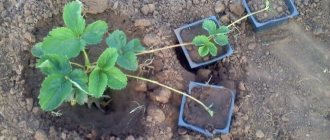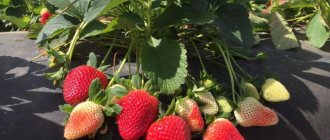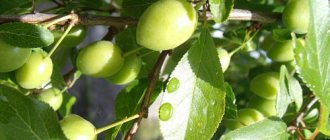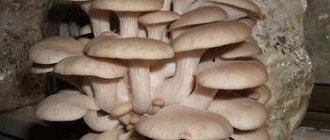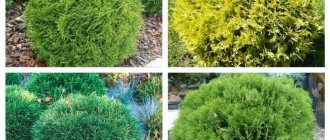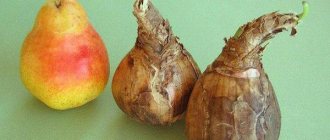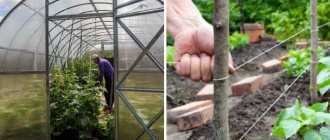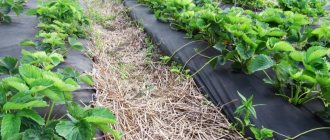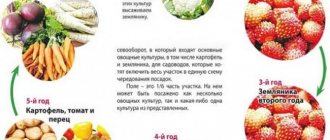Every gardener knows how capricious everyone's favorite strawberry can be. The bushes of this plant require frequent weeding, watering and care for the tendrils. To make work easier in the country, a clever way has been invented - planting strawberries under black covering material or mulching.
This technology will save you from additional work and protect your berry bushes from the harmful effects of external factors.
Benefits of Mulching
Planting strawberries under black covering material has a number of advantages:
- The soil, covered with special material, does not dry out and does not require frequent watering.
- An optimal microclimate is created inside.
- The soil under the film becomes attractive to earthworms, which loosen and fertilize the beds for the benefit of the crop.
- Thanks to the protective material, the sun does not shine on the soil and weeds do not grow. That is, you don’t have to resort to constant tedious weeding.
- Strawberry roots grow better under the film, saturating the berries with all useful microelements.
- It will be easier to get rid of excess strawberry tendrils - they will not be able to grow into the ground, which means that it is enough to simply cut them off.
- Frost resistance of plants increases.
- Strawberries ripen faster.
- You won’t have to wash the berries for a long time, because thanks to the covering material they will not come into contact with the soil and will remain clean.
Design selection
Sellers offer several options for planting under agrofibre, of which these are white and black.
In the first case, the device is used after planting, the bushes are covered to create greenhouse conditions.
Due to its shading properties, white material is suitable for southern regions
In the second case, the structure is an alternative to the mulch layer, but not all of the plant is covered; bushes should appear from the holes made.
Black agrofibre is durable, strong, but too dense, which prevents the penetration of sunlight
Knowing the required material density and width, which should be 1 m or more greater than the width of the bed, will help you choose correctly. It is recommended to purchase agrofilm with a density of 40-60 g/m2, which will effectively protect strawberries in winter, protect them from weeds and other things.
Variety of covering materials
There are many types of special covering materials for garden crops. The following are suitable for strawberries:
- Agrofibre. It is considered one of the best materials for growing strawberries. It allows moisture and air to pass through better than others, while protecting against temperature changes, sunlight and pests.
- Agrospan. It protects roots well from frost and provides air exchange. Its homogeneous structure affects its durability - it can last up to 4 years.
- Spunbond. This is a synthetic fabric that is also durable and strong. Has the same service life - 4 years.
- Lutrasil. The material is a little less resistant to the sun, but it repels moisture well and is not afraid of the greenhouse effect.
- Spunwhite. Lightweight and durable polypropylene fabric that allows moisture and air to pass through.
In principle, any of the listed materials copes well with its tasks. The choice is yours. Most importantly, keep in mind that using regular plastic film is not recommended. It does not allow air to pass through and creates a greenhouse effect, which can have a detrimental effect on the entire berry harvest.
It is also worth noting that in harsh climatic conditions it is worth choosing a denser material, and in the southern regions - a lighter one.
What is agrofibre for strawberries?
Agrofibre (or spunbond) is the most modern and effective material used in agriculture. Essentially it is a non-woven polymer fabric with special impregnation. It has a homogeneous structure and does not transmit ultraviolet radiation. Easily ventilated, has high tensile strength. In terms of physical properties, this material is lightweight and soft.
Spunbond has come to replace conventional polyethylene film, which has many disadvantages. When used correctly, this material lasts at least 2-3 years. Available in different sizes, densities and colors.
Planting strawberries under black covering material: in spring or autumn?
What time of year is it better to plant strawberries - spring or autumn? There is constant controversy surrounding this issue. After all, both options have their advantages.
It is believed that spring strawberries take root quickly and overwinter better. However, in this case, plant bushes do not always produce a harvest in the first season.
Autumn strawberries (we are talking about strawberries planted in mid-to-late August in the northern and central regions) will bear fruit by the new season. The disadvantage is that at very low temperatures not all plants will be able to survive the winter.
Hence the conclusion: if you live in the South, calmly plant berries in the fall. But northerners should opt for planting strawberries under covering material in the spring.
Pros and cons of spunbond when growing strawberries
As a covering material for strawberries, agrotextiles have significantly more positive than negative properties.
The advantages of the material include:
- Minimum investment of funds for caring for garden crops.
- Reducing the number of waterings.
- Reliable protection against birds, weeds, slugs, mole crickets, ants and other pests.
- Easy to harvest and remove unwanted tendrils. Being on the surface of the canvas, the berries do not rot and remain clean even after watering.
- Protecting strawberry beds from low temperatures.
- Reducing the risk of fungal infections.
- Acceleration of the growing season, early ripening of berries.
It is important to know!
Agrofibre contains no toxic substances, which indicates the safety of the product for human health and the environment.
Strawberries grown under spunbond will be environmentally friendly because they do not require the use of chemicals.
Agrotextiles have significantly fewer disadvantages. These include the higher cost compared to conventional film and the initially uneven moisture transmission of the new material. Over time, the spunbond adapts to watering and moistening occurs evenly.
Where is the best place to plant strawberries?
- Juicy strawberries prefer to grow in elevated and well-lit places. She loves quiet corners, sheltered from strong winds. The ideal place is a bed near the garden or an area between low trees.
- Strawberries grow well in soil after garlic, onions, carrots, legumes and cereals.
You cannot plant strawberries:
- after cucumbers, cabbage, peppers and potatoes. It is believed that the berries in these places will not produce a harvest;
- in lowlands and places that are constantly flooded. Capricious strawberries cannot tolerate strong humidity.
Rules of care
Proper care of strawberries will allow you to get high yields:
- Dry and waterlogged soil is harmful to strawberries. In the summer heat, watering in the form of drip irrigation is carried out 2-3 times every 7 days. It is advisable to carry out the procedure in the evening. If the days are cool, the period between watering increases.
- In the first year of life, strawberries are not fed as the soil received enough nutrients during the organization of the beds.
- Berries on agrofibre are much cleaner than those on soil.
The crop is fed with liquid fertilizers special for strawberries. - The first feeding is applied in the spring, in the second year of life before flowering.
- A phosphorus-potassium mixture is prepared: 60 g of superphosphate, 150 g of potassium nitrate or potassium sulfate, humus with water 1:5. The row spacing is watered (1 bucket per 3 m).
- Similar feeding is repeated in the second phase of active development.
- The next organic fertilizer is applied after picking the berries. Dosage: 10 g of ammonium nitrate per 5 liters of water.
- The third and fourth years are accompanied by inorganic feeding.
- In spring, old leaves are cut off.
In the summer, the mustache and all foliage, except for young leaves, are removed.
Preparatory work
Before planting strawberries, the bed needs to be prepared. The soil must be dug up and all weeds and any remnants of rhizomes must be removed. Afterwards the soil is fertilized. Suitable for fertilizer:
- compost;
- humus;
- straw;
- special purchased products.
It is also important to consider the type of soil. Strawberries love black soil. However, black soil is not available everywhere. How to fix the situation? There is an exit.
The properties of sandy soil can be improved by adding white clay, peat and organic fertilizers. Experienced gardeners advise adding ash, sand or compost to clay soil.
If a large area is planned for strawberries, it is important to install an irrigation system in advance so as not to irrigate each bush separately.
How to plant?
Once the beds are ready, you should move on to mulching. Straw mixed with grass can be used as mulch.
The combined mulching method will prevent the formation of fungi.
The film is laid on top.
Regular seedlings are planted to a depth of 10–12 cm, and the roots should be cut to 9 cm.
For seedlings with a closed bark system, the holes are prepared a little deeper, since they are planted in cups.
Rosettes of leaves are placed above ground level.
Step-by-step instruction
- A sunny place is prepared and the site is cleared of weeds.
- The soil is dug up with the addition of organic fertilizers.
- The rows are mulched and covered with agrofibre.
- Marking of seats is done.
- The seedlings are planted in prepared holes, which are made using a round stick. Then the roots will go well down. If the roots turn out to be bent, they will rot and will not be accepted.
- Before planting, the roots are dipped in a solution of water with potassium permanganate and carefully covered with soil.
- The corners of the canvas are folded inward.
- Each bush is watered abundantly.
- The next watering is done after a few days (2-3 days).
- When planting strawberries on agrofibre, drip irrigation is subsequently used.
How to plant strawberries under black covering material: technology and basic rules
- After preparing the soil, we move on to the main stage. It is better to start work in warm weather. Immediately before planting, the soil must be watered and rows formed in the garden bed.
- If you are not going to install an irrigation system, it is best to make recesses between the rows. This will make it easier to care for the bushes. Plant 3-4 rows in each mini-bed, no more.
- The soil is leveled with a rake. And then the covering material is attached. To do this, use heavy stones, bricks, boards, and so on. Some people simply dig in the edges of the material.
- Then cuts are made at the site where the bushes are planted. Most often these are cross-shaped cuts, the edges are unrolled and folded under the film.
- Some create small round holes for planting. But this takes more time.
- There should be approximately 30-35 cm between seedlings, and at least 40 cm between rows.
- To plant, dig a small hole, no more than the depth of a scoop. Plant the strawberry bush so that the growing point is level with the surface of the earth. The roots remaining on the surface should be sprinkled with soil.
